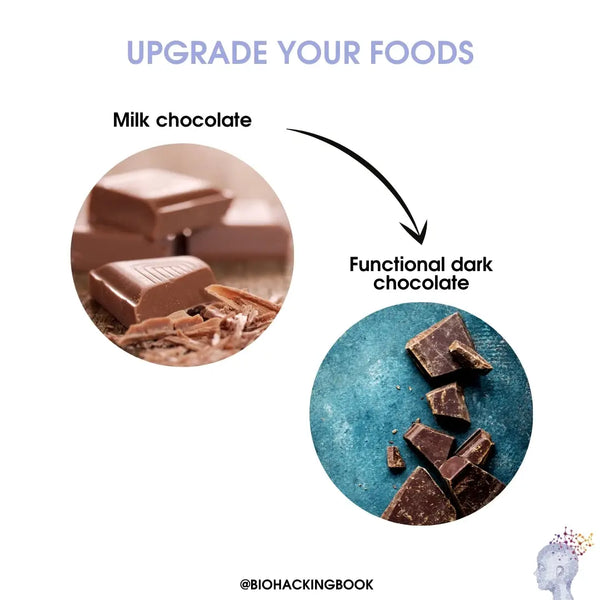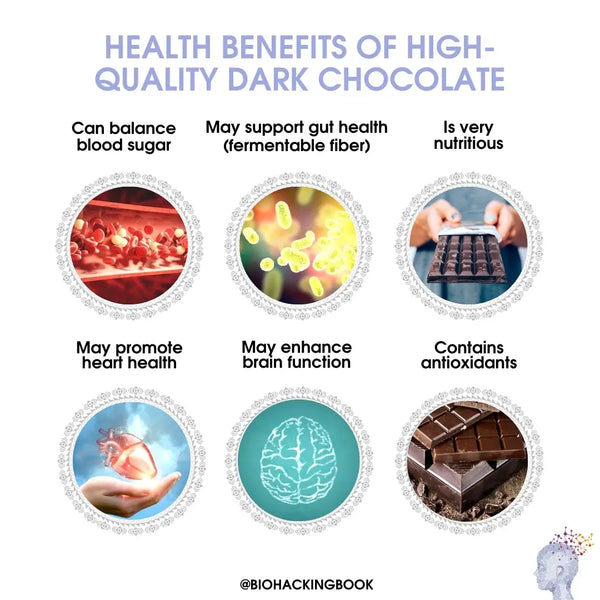High-quality chocolate is the biohacker’s go-to treat: it is rich both in taste and nutrients. When it comes to chocolate, aim for a high-quality one with at least 70-85 % of cocoa solids – the higher the percentage the higher the nutrient density. Commercial milk chocolate is not optimal food. It usually contains low levels of cocoa and plenty of fillers including sugar, milk, and even gluten. Recently, a healthier option (raw chocolate), has become a popular alternative for commercial chocolate products. Raw chocolate is made of (mostly) unroasted cacao beans, cacao butter (theobroma oil), and low levels of some sweetener that is not white sugar (such as stevia, cane sugar, coconut sugar, xylitol, or lucuma). Find biohacker-approved raw chocolates here.

The original name of the cacao plant is Theobroma cacao, where theobroma (from Latin) means the food of the Gods. The word Cacao is derived from an Aztecan word “cacahuatl” meaning the bean of the cocoa tree. Thus, the full name Theobroma cacao includes a powerful statement: cacao is the food of the gods. The high valuation and reputation come from its special ingredients that are known to have aphrodisiac properties.
FLAVANOLS
Chocolate and cocoa contain flavanols such as catechins and proanthocyanidins. They promote cardiovascular health and elasticity of blood vessels. Flavanols can also support blood flow in the brain, and hence cognitive functions. Their high antioxidant capacity may also have neuroprotective properties. Therefore, having 1-2 pieces of chocolate as a dessert may support focus and prevent a post-meal slump in energy.
IRON
Dark chocolate contains approximately 8 mg / 100 g iron. When it comes to iron, optimal levels are key. You should avoid having too low, but also too high levels of iron. Therefore, it might be worthwhile to measure your iron levels and consume chocolate accordingly.
POLYPHENOLS
Dark chocolate contains polyphenols & fermentable fibers, which support a healthy gut microbiota. This, in turn, may help with weight loss.
MAGNESIUM
Dark chocolate contains around 146 mg / 100 g of magnesium. Magnesium is one of the key minerals in more than 200 metabolic reactions and has significant health benefits (e.g., prevents stress, depression, and improves the quality of sleep). Given this, chocolate is definitely a healthy treat!

THEOBROMINE
Theobromine is an alkaloid that has a stimulating effect similar to caffeine although - milder and longer-lasting. It can support cardiovascular health as well as boost cognitive functions. Therefore, you might want to limit chocolate-intake in the evenings and rather have it as an afternoon treat!
ANANDAMIDE
Anandamide is a neurotransmitter, naturally produced in the body, that binds into the cannabinoid brain receptors in the endocannabinoid system. Anandamide is important for memory, motivation, and higher thought processes in the brain. It could also be behind the euphoric feeling you get when eating high-quality chocolate. Cocoa beans contain small amounts of anandamide and also chemicals similar to it, which slow its breakdown thus intensifying the effects.
PHENYLETHYLAMINE
Chocolate has the highest phenylethylamine in any food. Phenylethylamine is a neurotransmitter that is produced in the brain when one is “in love”. Phenylethylamine works by stimulating the brain's pleasure centers, thus promoting feelings of excitement and attraction. No wonder chocolate is one of the most popular treats in the world.
In conclusion, pamper yourself with high-quality and enjoy these various health benefits!
- - -
How do you like to enjoy chocolate? Share your tips in the comments!





